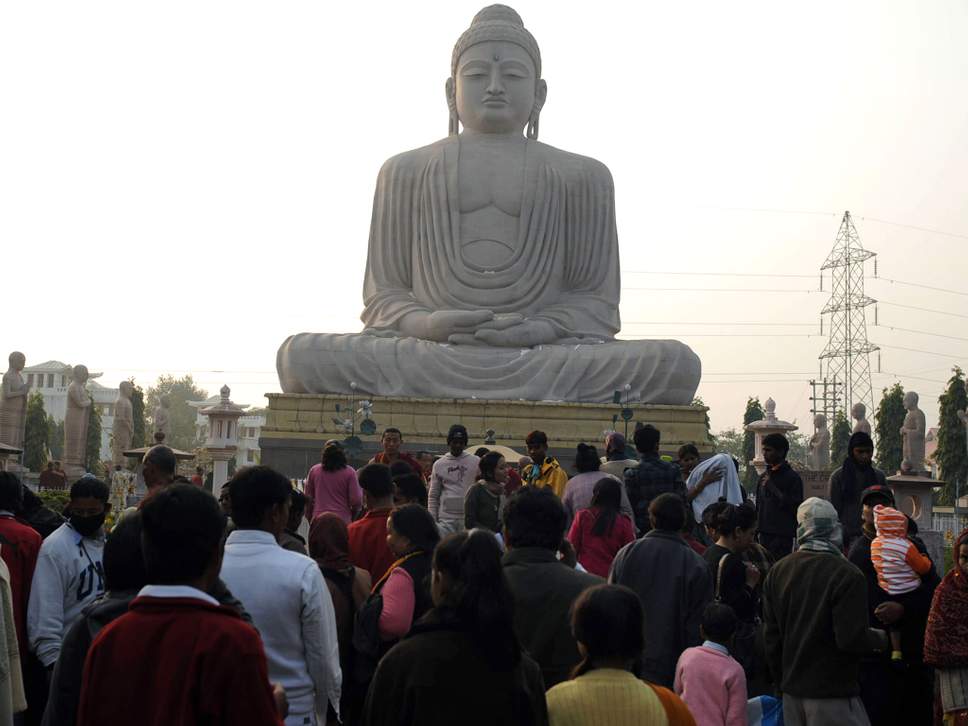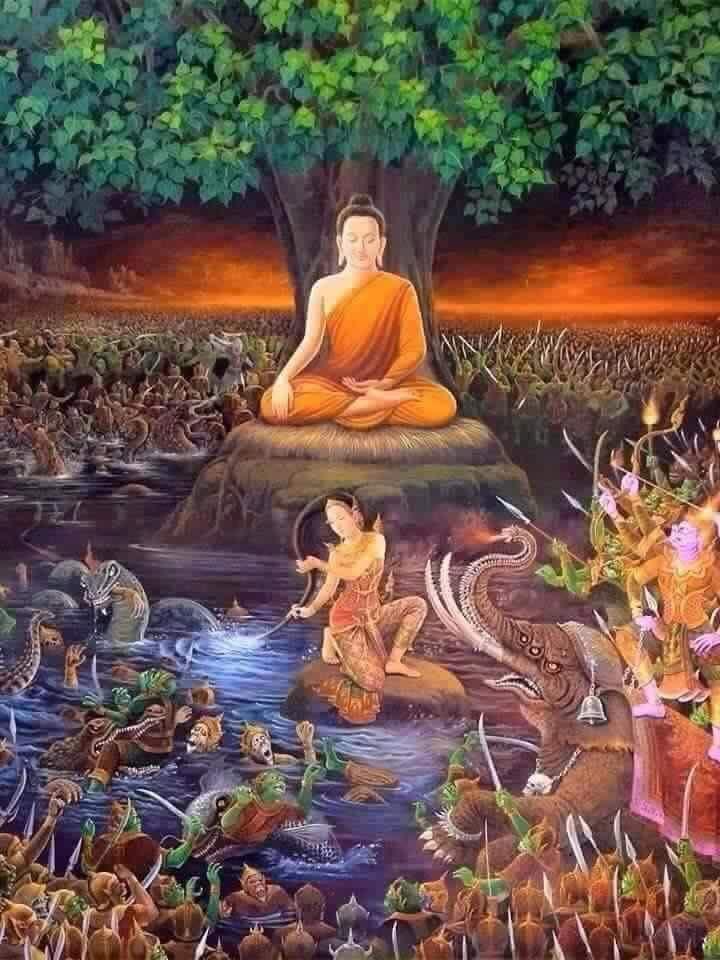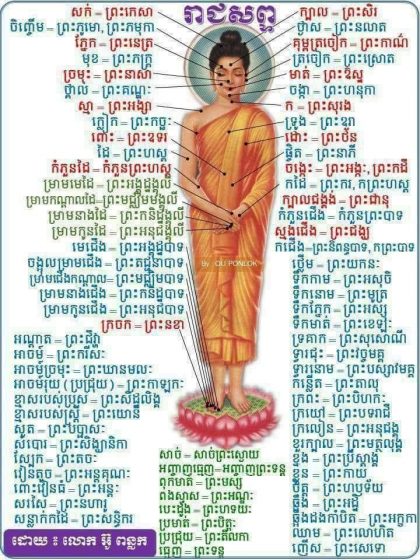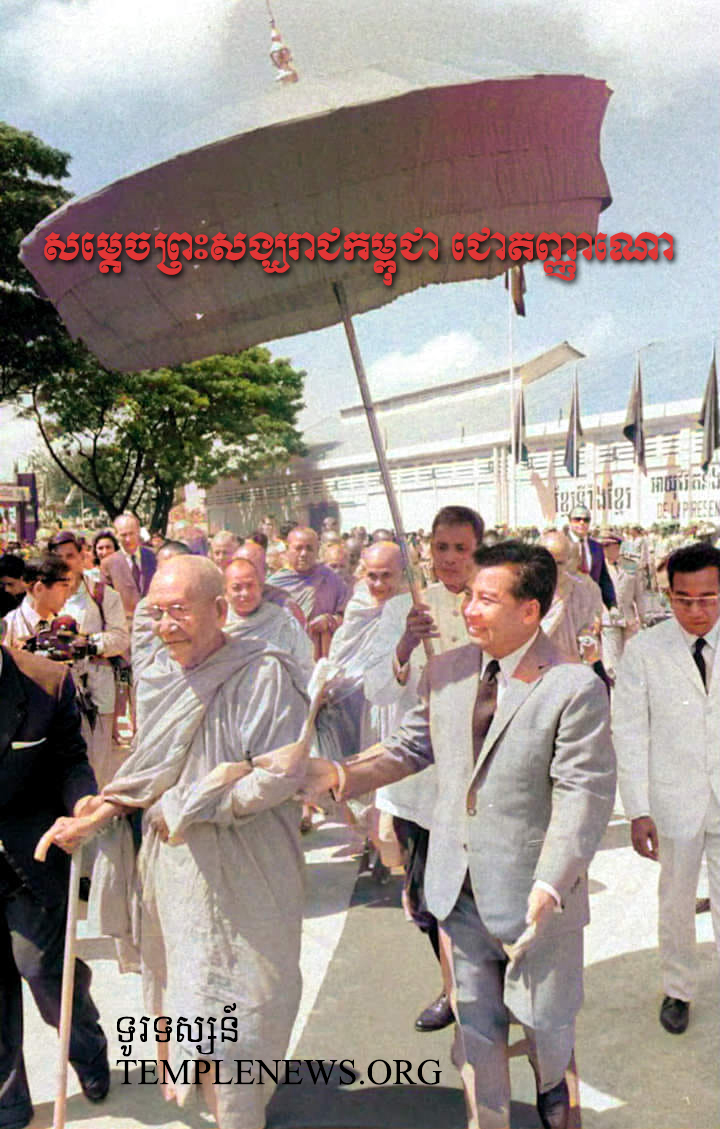
ព្រះសម្មាសម្ពុទ្ធនៅពុទ្ធគយា ប្រទេសឥណ្ឌា The ‘Great Statue of Lord Buddha’ in Bodhgaya (file photo) ( AFP/Getty Images )
The post The ‘Great Statue of Lord Buddha’ in Bodhgaya appeared first on Templenews.
ព្រះសម្មាសម្ពុទ្ធនៅពុទ្ធគយា ប្រទេសឥណ្ឌា The ‘Great Statue of Lord Buddha’ in Bodhgaya (file photo) ( AFP/Getty Images )
The post The ‘Great Statue of Lord Buddha’ in Bodhgaya appeared first on Templenews.
The post The Buddha preaching the Abhidharma in Trāyastriṃśa heaven appeared first on Templenews.
និព្វាន បកស្រាយដោយសម្ដេចព្រះសង្ឃរាជ សម្ដេចព្រះមហាសុមេធាធិបតី ជោតញ្ញាណោ
The Revered Supreme Buddhist Patriarch Jotannano of Cambodia on Nibbāna (Nirvāṇa)
The post និព្វាន បកស្រាយដោយសម្ដេចព្រះសង្ឃរាជ ជោតញ្ញាណោ Supreme Patriarch Jotannano on Nibbāna (Nirvāṇa) appeared first on Templenews.
ថ្ងៃចន្ទ ៤កើត ខែចេត្រ ឆ្នាំច សំរឹទ្ធិស័ក ព.ស.២៥៦២ ត្រូវនឹងថ្ងៃទី៨ ខែមេសា គ.ស.២០១៩
Monday the 4th Waxing Moon of Citta B.E.2562, April 8, A.D.2019 Year of the Dog
គ្មានការត្រាស់ដឹងរបស់ព្រះសម្មាសម្ពុទ្ធទាំងឡាយណាគ្រប់ព្រះអង្គដែលថាគ្មានមារជាសត្រូវមិនមកផ្ចាញ់ផ្ចាល់់នោះឡើយ ហើយព្រះអង្គមិនមែនចេះខន្តីទុកឲ្យមារជាសត្រូវធ្វើព្យុះភ្លៀងស្រេចតែចិត្តនោះដែរ ព្រះអង្គតបតផ្ចាញ់ផ្ចាល់វិញដោយវិធីរបស់ព្រះអង្គដែលយើងគ្រប់រូបអ្នកគោរពព្រះពុទ្ធសាសនាមិនទាន់យល់ដល់ដូចក្នុងរូបភាពនេះ។
មារមានទាំងនៅក្នុងគន្ធធុរៈ មានទាំងនៅក្នុងវិបស្សនាធុរៈ គឺមាននៅក្នុងចិត្ត មានទាំងនៅខាងក្រៅចាំតែរំខានជុំវិញខ្លួនយើង តែប្រសិនបើយើងមិនតបតកម្ចាត់មារជាសត្រូវទាំងនៅក្នុងចិត្តទាំងនៅចំពោះមុខដោយបញ្ញាទេមាននោះវានៅតែជាឧបស័គ្គរារាំងនូវដំណើរនៃឆាកជីវិតយើងមិនអាចធ្វើដំណើរទៅមុខបានដោយជោគជ័យដល់ទិសដៅបានឡើយ។
ដូច្នេះព្រះអង្គទ្រង់ក៏តបតផ្ចាញ់មារវិញដែរធ្វើឲ្យពួកមារជាសត្រូវរត់ខ្ចាត់ត្រឡប់ទៅវិញអស់ ដូចឈុតឆាកនេះ យើងត្រូវចេះពិចារណាដោយបញ្ញា កុំទុកឲ្យមារជាសត្រូវធ្វើអ្វីមកលើជីវិតយើងស្រេចតែចិត្ត ដូចពាក្យស្លោកពោលថា៖
ផ្លូវវៀចកុំឲ្យបោះបង់ ផ្លូវណាត្រង់ឲ្យដើរផង មិនមែនត្រង់រហូតគេធ្វើបាបខ្លួនប្រាណយើងហើយមិនហ៊ានតបតនោះឡើយ។
មិនគួរចិត្តល្អចំពោះអ្នកដទៃ ហើយឃោរឃៅដាក់ខ្លួនឯងនោះដែរ ចូរពិចារណារកហេតុផលទាំងអស់គ្នា សូមអនុមោទនា។
The post ព្រះសម្មាសម្ពុទ្ធផ្ចាញ់មារ The Buddha Defeating Mara appeared first on Templenews.
វត្ដគិរីវង្សាបុប្ផារាម អាស្រមសមាធិសន្ដិភាព នឹងប្រារព្ធពិធីបុណ្យមាឃបូជា ថ្ងៃសៅរ៍ ១៥កើត ពេញបូណ៌មី ថ្ងៃសីល ឆ្នាំកុរ ឯកស័ក ព.ស.២៥៦៣ ត្រូវនឹងថ្ងៃទី៨ ខែកុម្ភៈ គ.ស.២០២០
The Kiryvongsa Bopharam Pagoda, the Peace Meditation Center to observe the Māgha Pūjā on Saturday the 15th Waxing Moon of Māgha, Day of Abstinence, B.E.2563 equivalent to February 8, A.D.2020.

Venue: The Kiryvongsa Bopharam Pagoda, the Peace Meditation Center
100A Cave Hill Road, Leverett, MA 01054 – 9728
Tel.: 413.367.0280, 413.367.2028
Māgha Pūjā is the second most important Buddhist festival, celebrated on the full moon day of the third lunar month in Cambodia, Laos, Thailand, Sri Lanka and on the full moon day of Tabaung in Myanmar. It celebrates a gathering that was held between the Buddha and 1,250 of his first disciples, which, according to tradition, preceded the custom of periodic recitation of discipline by monks. On the day, Buddhists celebrate the creation of an ideal and exemplary community, which is why it is sometimes called Saṅgha Day, the Saṅgha referring to the Buddhist community, and for some Buddhist schools this is specifically the monastic community. In Thailand, the Pāli term Māgha-pūraṇamī is also used for the celebration, meaning ‘to honor on the full moon of the third lunar month’. Finally, some authors have also referred to the day as the Buddhist All Saints Day.
Celebration of Māgha Pūjā is first known of in the modern period, with the institution of it in Thailand, by King Rama IV (A.D.1804 – A.D.1868). It is a public holiday in many Southeast Asian countries and is an occasion when Buddhists go to the temple to perform merit-making activities, such as alms giving, meditation and listening to teachings. It has been proposed as a more spiritual alternative to the celebration of Valentine’s Day.
Māgha is derived from the name of the third month in the traditional Indian lunar calendar, on which the celebration is held. It is also the name of a star, which during this period is close to the full moon. Māgha Pūjā is held on the full moon day. In a leap year, the celebration will be postponed to the full moon day of the fourth lunar month.
Māgha Pūjā day marks an event occurring at the Veḷuvana grove, near Rājagaha (present Rajgir) in northern India, ten months after the enlightenment of the Buddha. The traditional story goes that a meeting is held in the afternoon, that has four characteristics:
1,250 disciples come to see the Buddha that evening without being summoned; These are mostly pupils from the Buddha’s recently converted disciples, such as the three Kassapa brothers, and the monks Sāriputta and Mogallāna.
All of them are Arahants, enlightened disciples;
All have been ordained by the Buddha himself, and therefore are his direct spiritual descendants;
It is the full-moon day of the third lunar month.
Because of these four factors, Māgha Pūjā is also known as the Fourfold Assembly Day. On this occasion, the Buddha teaches those arahants a summary of Buddhism, called the Ovādapatimokkha. In these, three principles are given:
“The non-doing of evil / the full performance of what is wholesome / the total purification of the mind.”
This is followed by a formulation of Buddhist ideals:
“Patience (and) forbearance are the highest austerity. The awakened ones say nibbāna is the highest. One is certainly not a wanderer if one injures others; one is not an ascetic if one harms another.”
Finally, the last stanza is about the path of religious practice:
“Not abusing, not injuring, and restraint under the rules of discipline, and knowing moderation in eating, and secluded lodgings, and exertion in respect of higher thought, this is the teaching of the awakened ones.”
According to the traditional Pāli commentaries, the Buddha continued to teach this summary for a period of twenty years, after which the custom was replaced by the recitation of the monastic code of discipline by the Saṅgha themselves. On Māgha Pūjā, Buddhists celebrate the creation of an ideal and exemplary community.
Māgha Pūjā is also the day that the Buddha is believed to have announced in Vesālī he would die in three months, after which a miraculous earthquake followed. Moreover, in Sri Lanka, it is considered the day that the Buddha appointed his two main disciples, the monks Sāriputta and Moggallāna. Apart from the religious meaning, Māgha Pūjā also reflects the Southeast Asian agricultural year, as it is celebrated after the harvest.
It is unknown how traditional Buddhist societies celebrated this event in pre-modern times, but in Thailand, the first known instance was during the reign of the Thai king Rama IV (1804–68), who instituted it. He first held it in the palace only. In the evening, 31 monks would recite the Ovādapatimokkha, lit lanterns around the ubosot (ordination hall), and give a sermon about the same Ovādapatimokkha. A recitation text used for this occasion is attributed to Rama IV. Rama IV’s successor Rama V (A.D.1853 – A.D.1910) expanded the practice and organized it as a national celebration in the Temple of the Emerald Buddha. From Thailand, the practice spread to neighboring countries. Already in A.D. 1937, the ceremony was widely held and observed in Thailand.
Māgha Pūjā is a day that laypeople make merit. Monastics and devotees will hold processions, light candles, and make offerings. Māgha Pūjā is celebrated most extensively in Cambodia and Thailand, but it is a national holiday in most Southeast Asian countries, such as Laos, Myanmar and Cambodia.
In Thailand, Māgha Pūjā was instituted by Rama IV. It is currently designated as a national holiday, on which sale of alcohol is strictly prohibited. On the evening of Māgha Pūjā, most temples in Thailand hold a candlelight procession. Furthermore, people will make merit by going to temples and by joining in with activities, such as listening to teachings, giving alms, etc. At times, special events are also held, such as a recital of the entire Buddhist scriptures and ceremonies for avowing oneself as a Buddhist lay person. In A.D.2006, the government of Thailand made an announcement that Māgha Pūjā should be celebrated as a “national day of gratitude.” Māgha Pūja was therefore presented as a day of spiritual love and gratitude instead.
In Sri Lanka and Cambodia, Māgha Pūjā is also observed. In Chinese communities, as well as in Myanmar, a similar festival as Māgha Pūjā is observed. The Burmese people celebrate this on the full moon of the month Tabaung according to their traditional calendar. Fifteen days before this full moon day, a Shwedagon Pagoda Festival is held, on which a ceremony is held for offerings to the 28 Buddhas (from Taṇhaṅkara to Gotama Buddha), followed by a 10-day, continuous recital of Buddhist texts. Burmese devotees make merits and meditate during this period.
Māgha Pūjā has also become a popular event among Western Buddhist converts in the West. Wikipedia
ផ្សាយនៅថ្ងៃចន្ទ ១២រោច ខែមិគសិរ ឆ្នាំកុរ ឯកស័ក ព.ស.២៥៦៣ ត្រូវនឹងថ្ងៃទី២៣ ខែធ្នូ គ.ស.២០១៩
Monday the 12th Waning Moon of Māgasira B.E.2563 equivalent to December 23, A.D.2019 Year of the Pig
The post Māgha Pūjā at Wat Kiryvongsa Bopharam on FEB 8, 2563/2020 appeared first on Templenews.
សម្ដេចព្រះសង្ឃរាជ ជោតញ្ញាណោ ជួន ណាត ទ្រង់ពន្យល់អំពីមិច្ឆាសង្កប្ប (តម្រិះខុស) និង សម្មាសង្កប្ប (តម្រិះត្រូវ)
His Holiness Sangharaja Jotannano giving explations on Micchā Sankappa (Wrong Intention) and Samma Sankappa (Right Intention)
ថ្ងៃអាទិត្យ ៥កើត ខែពិសាខ ឆ្នាំជូត ទោស័ក ព.ស.២៥៦៣ ត្រូវនឹងថ្ងៃទី២៦ ខែមេសា គ.ស.២០២០
Sunday the 5th Waxing Moon of Visakha B.E.2563 equivalent to April 26, A.D.2020 Year of the Rat
សម្ដេចព្រះសង្ឃរាជ ជោតញ្ញាណោ ជួន ណាត ទ្រង់ពន្យល់អំពីមិច្ឆាសង្កប្ប (តម្រិះខុស) និង សម្មាសង្កប្ប (តម្រិះត្រូវ)
Micchā Sankappa (Wrong Intention.) and Samma Sankappa (Right Intention)
Micchā Magga: Atthangika: the ‘8-fold wrong path’, is:1. Wrong view Micchā Ditthi, 2. Wrong Motivation Micchā Sankappa, 3. Wrong Speech Micchā Vvācā, 4. Wrong Bodily Action Micchā Kammanta, 5. Wrong Livelihood Micchā Ājīva, 6. Wrong Effort Micchā Vāyāma, 7. Wrong Awareness or Mindfulness Micchā Sati, 8. Wrong Concentration Micchā Samādhi
Samma Sankappa takes its name from the ancient Pali language, and translates as Right Intention or Right Resolve – one of the principle steps of The Noble Eightfold Path, from the Magga Vibhanga Sutta teachings taught by Buddha Shakyamuni – and of great importance to Buddhist practitioners.
The post សម្ដេចព្រះសង្ឃរាជ ជោតញ្ញាណោ ជួន ណាត ទ្រង់ពន្យល់អំពីមិច្ឆាសង្កប្ប (តម្រិះខុស) និង សម្មាសង្កប្ប (តម្រិះត្រូវ) appeared first on Templenews.
ពាក្យជាភាសាខ្មែរ និង បាលី សម្រាប់ព្រះភិក្ខុសង្ឃ និង គ្រហស្ថ សន្ទនាជាមួយ និង ចំពោះព្រះសង្ឃ
Khmer and Pali words, vocabularies when Buddhist monks and laypeople converse among, with and toward the Buddhist monks
ថ្ងៃអាទិត្យ ១១រោច ខែពិសាខ ឆ្នាំជូត ទោស័ក ព.ស.២៥៦៤ ត្រូវនឹងថ្ងៃទី១៧ ខែឧសភា គ.ស.២០២០
Sunday the 11th Waning Moon of Visakha B.E.2564 equivalent to May 17, A.D.2020 Year of the Rat

The post Khmer, Pali Words, Vocabularies When Converse Among, with and toward the Buddhist monks appeared first on Templenews.
ធម្មទេសនា ស្ដីពី មហាវេស្សន្តរជាតក សម្ដែងដោយសម្តេចព្រះសង្ឃរាជ ជោតញ្ញាណោ ជួន ណាត និងសម្តេចព្រះសង្ឃរាជ វជិរប្បញ្ញោ ហួត តាត
Dhamma Talk on Maha Vessantara Jātaka giving by H.H. Jotannano Chuon Nath and H.H. Vajirapanno Huot Tath
ថ្ងៃពុធ ៥រោច ខែជេស្ឋ ឆ្នាំជូត ទោស័ក ព.ស.២៥៦៤ ត្រូវនឹងថ្ងៃទី១០ ខែមិថុនា គ.ស.២០២០
Wednesday the 5th Waning Moon of Jeṭṭha B.E.2564 equivalent to June 10, A.D.2020 Year of the Rat
ធម្មទេសនាដ៏ពិរោះ ប្រទានដោយសម្តេចព្រះសង្ឃរាជ ជោតញ្ញាណោ ជួន ណាត និងសម្តេចព្រះមហាសុមេធាធិបតី វជិរប្បញ្ញោ ហួត តាត
Dhamma Talk on Maha Vessantara Jātaka giving by His Holiness The Great Dr. Jotañano Chuon Nath (the late Supreme Buddhist Patriarch of Cambodia) and His Holiness Vajirapanno Huot Tath (the late Supreme Buddhist Patriarch of Cambodia)
ផ្សាយជាធម្មទានដោយវត្តវារិន្ទព្រែកលៀប រាជធានីភ្នំពេញ ០២ ឧសភា ព.ស.២៥៦៣ គ.ស.២០២០
The post ធម្មទេសនា ស្ដីពី មហាវេស្សន្តរជាតក appeared first on Templenews.
ទោសភិក្ខុ សាមណេរ អ្នកដែលមិនបានពិចារណាបច្ច័យបួន
Punishment, Penalty for Buddhist monks, who do not value Paccaya
៥ អយោគុឡនរក ប្រែថា៖ នរកដុំដែក គឺនរកនេះ មានដុំដែកក្តៅ ពួកនាយនិរយបាលថ្កៀបដុំដែក ដែលភ្លើងកំពុងឆ្លេះបុករុកតាមមាត់ធ្វើឲ្យស៊ីខ្លះ, ថ្កៀបកខ្លះ, ថ្កៀបត្រចៀកខ្លះ, ថ្កៀបខ្លួនខ្លះ, បានសេចក្ដីទុក្ខក្តៅអន្ទះសាជានិច្ច។ ទោសធ្លាក់នរកនេះ មកពីលួចសត្វពាហនៈគេ, លួចខ្ញុំកំដរគេ, បុកឈើ ឬដែកតាមមាត់សត្វ, (ជាភិក្ខុ សាមណេរប្រើប្រាស់បច្ច័យ ៤ មិនបានពិចារណា), ប្តីជេរប្រពន្ធៗជេរប្តី មិនគោរពគ្នា។ ដកស្រង់ពីសៀវភៅព្រះមាល័យទេសនា ទំព័រ ២១។ ភិក្ខុ ភទ្ទបណ្ឌិតោ
ថ្ងៃពុធ ១២កើត ខែអាសាឍ ឆ្នាំជូត ទោស័ក ព.ស.២៥៦៤ ត្រូវនឹងថ្ងៃទី១ ខែកក្កដា គ.ស.២០២០
Wednesday the 12th Waxing Moon of Āsāḷha B.E.2564 equivalent to July 1, A.D.2020 Year of the Rat

Paccaya means support, condition, supported condition , cause.
The post ទោសភិក្ខុ សាមណេរ អ្នកដែលមិនបានពិចារណាបច្ច័យបួន appeared first on Templenews.
ព្រះធម្មទេសនា ស្តីពីជំនឿក្រៅព្រះពុទ្ធសាសនា ដេាយ ព្រះធម្មវិបស្សនា កេតុធម្មោ សំ ប៊ុនធឿន
“សត្វបរោខោ ទំមែកពោធិ៍ សុីផ្លែជ្រៃ”
Dhamma talk on Buddhism & Superstitions by the late and renowned Cambodian Vipassana Buddhist Master Ven. Ketodhammo Som Bunthoeun.
Superstition has no place in Buddhism.
Buddhism is strictly not a religion in the context of being a faith and worship owing allegiance to a supernatural being.
The Buddha rejects superstitions but urges us to pursue wisdom. The Buddha teaches us to develop the most important practices: self-discipline, self-restraint, cultivation of morality and spiritual development. The Buddha also teaches us to cultivate the strength of will-power, wisdom, understanding of Mind and self-nature.
The post ជំនឿក្រៅព្រះពុទ្ធសាសនា ដេាយ ព្រះធម្មវិបស្សនា កេតុធម្មោ សំ ប៊ុនធឿន appeared first on Templenews.
ព្រះធម្មទេសនាស្តីពី បរិយត្តិ និង បដិបត្តិ និង ជំនឿត្រូវ ៤ យ៉ាង ក្នុងព្រះពុទ្ធសាសនា ដេាយ ព្រះធម្មវិបស្សនា កេតុធម្មោ សំ ប៊ុនធឿន
Dhamma talk on pariyatti and patipatti and the four types of faith in Buddhism by the late and renowned Cambodian Vipassana Buddhist Master Ven. Ketodhammo Som Bunthoeun.
សទ្ធាមាន ៤ យ៉ាងគឺ៖
១. កម្មសទ្ធា ការជឿកម្ម។
២. វិបាកសទ្ធា ការជឿផល។
៣. កម្មស្សកតាសទ្ធា ការជឿថាសត្វទំាងឡាយមានកម្មដែលខ្លួនធេី្វហើយ ជារបស់ខ្លួន។
៤. តថាគតពោធិសទ្ធា ការជឿសេចក្តីត្រាស់ដឹងរបស់ព្រះតថាគត។
សុទ្ធិ អសុទ្ធិ បច្ចត្តំ នាញ្ញោ អញ្ញំ វិសោធយេ
សេចក្ដីបរិសុទ្ធ និង មិនបរិសុទ្ធជារបស់ចំពោះខ្លួន អ្នកដទៃនឹងធើ្វអ្នកដទៃឱ្យបរិសុទ្ធ ពុំបានឡើយ។
The post ព្រះធម្មទេសនាស្តីពី បរិយត្តិ និង បដិបត្តិ និង ជំនឿត្រូវ ៤ យ៉ាង ក្នុងព្រះពុទ្ធសាសនា appeared first on Templenews.
ព្រះធម្មទេសនាស្តីពី សិក្ខាបទ ៥, ៨, ១០, បាដិមោក្ខ, បរាជិក៤ និង ជំនឿ ៤ យ៉ាង ដោយ ព្រះធម្មវិបស្សនា កេតុធម្មោ សំ ប៊ុនធឿន
Dhamma talk on the 5, 8, and 10 precepts, the patimokkha, the four parajikas and four types of faith and by the late and renowned Cambodian Vipassana Buddhist Master Ven. Ketodhammo Som Bunthoeun.
The four parajikas for bhikkus are:
1. Sexual intercourse: engaging in any sexual intercourse.
2. Stealing: the robbery of anything worth more than 1/24 troy ounce of gold (as determined by local law).
3. Intentionally bringing about the death of a human being — whether by killing the person, arranging for an assassin to kill the person, inciting the person to die, or describing the advantages of death.
4. Deliberately lying to another person that one has attained a superior human state, such as claiming to be an arahant when one knows one is not, or claiming to have attained one of the jhanas when one knows one has not.
បារាជិក៤៖
១.មេថុនធម្ម ភិក្ខុសេពមេថុនធម្មត្រូវអាបត្ដិបារាជិក។
២.អទិន្នាទាន ភិក្ខុលួចទ្រព្យគេ ដោយយ៉ាងតិចបំផុតតាំងពីតម្លៃ ៥មាសឡើងទៅត្រូវអាបត្ដិបារាជិក។
៣.មនុស្សវិគ្គហ ភិក្ខុក្លែងសម្លាប់មនុស្ស ត្រូវអាបត្ដិបារាជិក។
៤.ឧត្ដរិមនុស្សធម្ម ភិក្ខុពោលអួត ឧត្ដរិមនុស្សធម្ម
គឺធម៌របស់មនុស្សក្រៃលែងដែលមិនមានក្នុងខ្លួនត្រូវអាបត្ដិបារាជិក។
បារាជិកមានន័យថា អ្នកចាលចាញ់ ចុះចាញ់ បរាជ័យ និងត្រូវវិនាសចេញពីញព្រះពុទ្ធវិន័យ ចេញពីបព្វជិតភាវៈ ជាអ្នកដាច់អាវាស ត្រូវលាចាកពីភិក្ខុភាវៈទៅជាឃរាវាសមនុស្សបរិស័ទធម្មតាវិញ។
ធម៌សិក្ខាបទទាំង ៤នេះ ប្រសិនបើភិក្ខុណាល្មើសធម៌ណាមួយ នឹងត្រូវអាបត្ដិបារាជិកហើយ ត្រូវតែលាចាកសិក្ខាបទចេញពីភិក្ខុភាវៈភ្លាម។
សទ្ធាមាន ៤ យ៉ាងគឺ៖
១. កម្មសទ្ធា ការជឿកម្ម។
២. វិបាកសទ្ធា ការជឿផល។
៣. កម្មស្សកតាសទ្ធា ការជឿថាសត្វទំាងឡាយមានកម្មដែលខ្លួនធេី្វហើយ ជារបស់ខ្លួន។
៤. តថាគតពោធិសទ្ធា ការជឿសេចក្តីត្រាស់ដឹងរបស់ព្រះតថាគត។
The post ព្រះធម្មទេសនាស្តីពី សិក្ខាបទ ៥, ៨, ១០, បាដិមោក្ខ, បរាជិក៤ និង ជំនឿ ៤ យ៉ាង appeared first on Templenews.
ព្រះសង្ឃដែលមិនសម្តែងបាដិមោក្ខ ត្រូវទុក្កដាបត្តិ
ព្រះធម្មទេសនាស្តីពី ឱវាទបាដិមោក្ខ និងសមុដ្ឋានរបស់សីល ដោយ ព្រះធម្មវិបស្សនា កេតុធម្មោ សំ ប៊ុនធឿន
Dhamma talk on Patimokkha and Uposatha day by the late and renowned Cambodian Vipassana Buddhist Master Ven. Ketodhammo Som Bunthoeun. Buddhist monks must recite the patimokkha, a concise compilation of the Vinaya on Uposatha day. On this day, both lay and ordained members of the sangha intensify their practice, deepen their knowledge and express communal commitment through millennia-old acts of lay-monastic reciprocity. It is a day for practicing the Buddha’s teachings and meditation.
The post ព្រះសង្ឃដែលមិនសម្តែងបាដិមោក្ខ ត្រូវអាបត្តិទុក្កដ appeared first on Templenews.
ព្រះធម្មទេសនាស្តីពីសីល និង វិន័យរបស់ភិក្ខុសង្ឃ ដោយ ព្រះធម្មវិបស្សនា កេតុធម្មោ សំ ប៊ុនធឿន
Dhamma talk on role of sila in Buddhist monasticism by the late and renowned Cambodian Vipassana Buddhist Master Ven. Ketodhammo Som Bunthoeun.
ព្រះពុទ្ធសាសនារុងរឿងទៅបានអាស្រ័យលើបរិស័ទទាំងបួនពួកគឺ ភិក្ខុ សាមណេរ ឧបាសក ឧបាសិកាទ្រទ្រង់ធម៌វិន័យដោយសុក្រឹត។ ភិក្ខុសាមណេរដែលមិនគោរពប្រតិបត្តិតាមពុទ្ធបញ្ញត្តិជាបុគ្គលទ្រុស្តសីល ហើយពុទ្ធបរិស័ទដែលជាអ្នកមានសតិនិងសម្បជញ្ញៈ ជាអ្នងមានសទ្ធាមុតមាំទៅលើព្រះពុទ្ធសាសនា នឹងលែងមានសទ្ធាចំពោះភិក្ខុទ្រុស្តសីល។
The post ព្រះធម្មទេសនាស្តីពីសីល និង វិន័យរបស់ភិក្ខុសង្ឃ appeared first on Templenews.
ព្រះធម្មទេសនាស្តីពី សីល សិក្ខាបទ កម្មបទ និងឧបោសថបង្គ្រប់កិច្ច ដោយ ព្រះធម្មវិបស្សនា កេតុធម្មោ សំ ប៊ុនធឿន
Dhamma talk pañca-sīla, attha-sīla, dasa-sīla, sikkhapada (religious rule), and kammapatha (courses of action) Buddhist monks by the late and renowned Cambodian Vipassana Buddhist Master Ven. Ketodhammo Som Bunthoeun.
លុយគឺជាអាសិរ្ពិស ជានុយសម្រាប់ទាក់កភិក្ខុសាមណេរឲ្យធ្លាក់ចុះទៅកាន់ហីភេទ
The post លុយគឺជាអាសិរ្ពិស ជានុយសម្រាប់ទាក់កភិក្ខុសាមណេរឲ្យធ្លាក់ចុះទៅកាន់ហីភេទ appeared first on Templenews.
A MUST READ
How to observe, organize the Kathina Dana Ceremony and achieve the maximum merits of Kathin.
Download PDF HistoryofKathinrevised10302564

The post History of Kathin appeared first on Templenews.
សម្ដេចព្រះសង្ឃរាជនៃប្រទេសកម្ពុជា សម្ដេច ជោតញ្ញាណោ ជួន ណាត
ថ្ងៃអង្គារ ៣កើត ខែចេត្រ ឆ្នាំជូត ទោស័ក ព.ស.២៥៦៤ ត្រូវនឹងថ្ងៃទី១៦ ខែមីនា គ.ស.២០២១
Tuesday the 3rd Waxing Moon of Citta B.E.2564 equivalent to March 16, A.D.2021 Year of the Rat

image Yeng Sampos
The post His Holiness Jotannano Chuon Nath, Cambodia’s Supreme Buddhist Patriarch appeared first on Templenews.
មិនមានសេចក្តីសុខដទៃក្រៅអំពីសេចក្តីស្ងប់ឡើយ។
In the Dhamma, it says “Natthi santi param sukham,” which means “There is no happiness greater than the peace of nibbāna.” This is the supreme happiness of nibbāna; this is supreme peace.
The post នត្ថិ សន្តិ បរំ សុខំ appeared first on Templenews.
សមោធានធាតុ | សម្ដែងដោយព្រះធម្មវិបស្សនា កេតុធម្មោ
ថ្ងៃចន្ទ ១១រោច ខែផល្គុន ឆ្នាំឆ្លូវ ត្រីស័ក ព.ស.២៥៦៥ ត្រូវនឹងថ្ងៃទី២៨ ខែមីនា គ.ស.២០២២
Monday the 11th Waning Moon of Phagguṇa B.E.2565 equivalent to March 28, A.D.2022 Year of the Cow
Thaney Buddhist Channel
Samodhanadhatu (The Buddha’s Relics) by the late Maha Thera Ketodhammo, the revered Vipassana Master
The post Samodhanadhatu (The Buddha’s Relics) appeared first on Templenews.
ថ្នាក់បឋមវិបស្សនា ដោយព្រះធម្មវិបស្សនា កេតុធម្មោ
Beginner’s Vipassana by the late Vipassana Master Bhikkhu Ketodhammo
ថ្ងៃអាទិត្យ ៨រោច ថ្ងៃសីល ខែភទ្របទ ឆ្នាំខាល ចត្វាស័ក ព.ស.២៥៦៦ ត្រូវនឹងថ្ងៃទី១៨ ខែកញ្ញា គ.ស.២០២២
Sunday the 8th Waning Moon, Holy Day, of Poṭṭhapāda B.E.2566 equivalent to September 18, A.D.2022 Year of the Tiger
The post ថ្នាក់បឋមវិបស្សនា ដោយព្រះធម្មវិបស្សនា កេតុធម្មោ appeared first on Templenews.